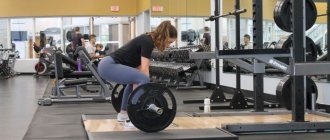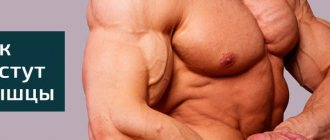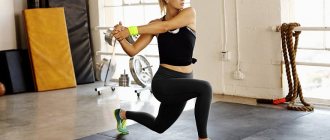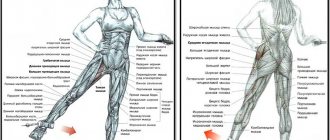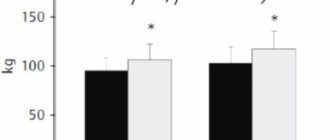Muscle growth is the process of increasing muscle fiber and surrounding tissue, requiring both physical training and adequate nutrition and adequate sleep. In this case, muscles grow precisely during sleep, when the body mobilizes reserves for recovery - including through the production of growth hormone.
What exactly makes muscles grow and what exercises are best for gaining muscle mass? How often should you exercise and how much protein should you include in your diet? You will find the answers in the material below.
The best exercises for muscle growth
The most effective effect on muscle growth and glycogen synthesis is the so-called “basic training”, which triggers the processes of hypertrophy. This training consists of performing multi-joint basic exercises that involve several large muscle groups at once.
Exercises should be performed in 5-7 repetitions with a heavy working weight - and this requires perfect knowledge of the technique. Such strength training provokes microdamage to muscle tissue, the subsequent restoration of which leads to muscle growth.
In addition, basic hypertrophy training has a positive effect on the body's production of a number of hormones necessary for muscle growth - primarily testosterone and growth hormone. Let us remind you that these same hormones affect fat burning and the appearance of relief.
What is hypertrophy?
Muscle hypertrophy is an increase in the body’s muscle mass due to the growth of individual groups of skeletal muscles. It is hypertrophy that means muscle growth and is the main goal in bodybuilding, since without muscle growth it is impossible to either increase their strength or increase their volume. The training strategy for hypertrophy is basic exercises and heavy working weights.
In turn, muscle hypertrophy is divided into two types - myofibrillar and sarcoplasmic hypertrophy. The first is achieved by increasing the volume of muscle fiber cells (while the actual number of cells remains virtually unchanged), the second is achieved by increasing the nutrient fluid surrounding this fiber. In simple words, the first affects strength, the second affects muscle volume.
Day 1 - Chest and Back
Body Twist - Russian Twist
- 4 sets of 20 reps
- Body Part: Press Equipment: No
Incline Dumbbell Press
- 4 sets of 12,10,8,8 repetitions
- Body part: Chest Equipment: Dumbbells
Dumbbell flyes lying on an incline bench
- 3 sets of 10-12 reps
- Body part: Shoulders Equipment: Dumbbells
Bringing hands together in crossover
- 3 sets of 12 reps
- Body Part: Chest Equipment: Block
Pull-ups
- 4 sets of 12,10,8,8 repetitions
- Body Part: Lat Equipment: Bodyweight
Reverse grip pull-ups
- 3 sets of 8-10 reps
- Body Part: Lat Equipment: Bodyweight
Downward pull of the upper block
- 3 sets of 10-12 reps
- Body part: Lat Equipment: Block
Add to Calendar * Add to My Workouts * Print Workout
* — The service is in beta testing
Shoulder and leg muscle training
Today is the main day of the week and you are working some of the most difficult muscles. Starting traditionally with the abs, I recommend doing 2-3 shoulder exercises at the beginning of your workout. This will allow you to accurately control the trajectory of movement, better feel your body and avoid losing control of the technique.
If desired, add a seated dumbbell press, a military press, or a Smith machine to the complex for a general workout of all the shoulder girdles.
How fast do professionals grow muscles after training?
Experienced athletes who have reached their genetic limit (maximum fiber density and mass) often resort to the hyperplasia technique.
Hyperplasia is a controlled increase in a fixed number of muscle fibers “above” what nature intended. One of the most difficult to reproduce, controversial, not fully studied and, rather, experimental technique, to achieve which it is necessary to spend about nine to ten months or more.
It consists of creating conditions for full cell division - tearing off part of the nucleus by overgrown tissues and creating a separate functional structure from them.
The determining factor that triggers hyperplasia is an excessively high anabolic background, which is unusual for the human body, which can be achieved by training using additional stimulants - sports nutrition and sports pharmacology.
The training is aimed at creating collapse through daily extreme loads with an emphasis on pumping.
Pumping is a high-intensity training complex with a large number of negative repetitions and short rest between approaches, during which more blood enters the muscles than they have time to pump out.
A set of anabolic steroids, peptide hormones, growth hormones and digestive enzymes in various combinations is used as additional stimulants.
Unbeknownst to you, you are eating too little
Too few calories is mistake #1. A person may be sure that he eats a lot, but if the muscles do not grow, despite training, it is still not enough.
Research shows that overweight people underestimate their calorie intake by 30-50%. This is the classic “I eat little, but I don’t lose weight.” But the opposite is also true: people who have difficulty gaining weight usually overestimate the amount they eat. They remember days when they ate a lot, but forget days when they ate too little. Also, “a lot” is a subjective concept: some people eat a very small amount of food (and thin people, in principle, are not inclined to overeat).
Some people simply don't have the appetite to eat enough to grow muscles. They may force themselves to eat a lot, but the metabolic control mechanisms strike back, and the person unnoticed eats less in subsequent meals or days. The dream of losing weight with a slow metabolism becomes a problem for those who want to gain weight.
Day 3 - hands
Crunches at the upper block while kneeling, working the oblique muscles
- 4 sets of 15 reps
- Body Part: Press Equipment: Block
Barbell curl
- 4 sets of 10 reps
- Body part: Biceps Equipment: Barbell
Alternating dumbbell curls while standing
- 2 sets of 12 reps
- Body part: Biceps Equipment: Dumbbells
Barbell curl
- 3 sets of 10 reps
- Body part: Biceps Equipment: Barbell
Dips
- 4 sets of 10 reps
- Body part: Triceps Equipment: Body weight
Seated French press
- 3 sets of 10-12 reps
- Body part: Triceps Equipment: Dumbbells
Wrist curl with a barbell while sitting on a bench, palms up
- 3 sets of 15-20 reps
- Body part: Forearms and wrists Equipment: Barbell
Add to Calendar * Add to My Workouts * Print Workout
* — The service is in beta testing
Muscle recovery
A mandatory element of quickly pumping up your muscles is stretching after training. There is never enough time or energy for them, and the effect is not visible to the naked eye. But truly this one addition to your training routine will take you to the next level.
Just the fact that all the professionals, like bodybuilders, lifters, and CrossFitters, emphasize this advice in their interviews should pique your interest in stretching. We offer the following complex.
The next element of rapid muscle recovery is a personal massage roller. A full body myofascial massage will be a quality addition to your post-workout muscle stretches.
The theory of “anatomical trains” has quite confidently proven the importance of fascial massage for the speedy recovery of the body, and the location of functional lines in the body suggests which parts of the body should be trained in combination with each other.
Finally, your recuperative repertoire should include a relaxing massage for athletes at least once a week.
Types of muscle fibers
Biochemistry lessons continue, and now we will take a detailed look at the muscles from the inside. Most likely, many people know that muscle fibers are divided into so-called fast and slow.
Oxidative muscle fibers
Oxidative muscle fibers, they are red, they are slow, they are type I fibers. Fibers of this type usually dominate in the muscles of the lower extremities of humans and in the muscles that support posture. Why are they oxidizing? The fact is that these fibers work only with access to oxygen and glucose and triglycerides are oxidized in them. Due to their high myoglobin content, they are red in color, hence their other name - red fibers.
Glycolytic muscle fibers
They are also called fast, white, type II fibers, and are divided into subtypes IIa and IIb. Type IIa is often called intermediate fibers because they have properties of both fast and slow fibers, but tend to be fast fibers. Lifting a barbell or jumping sharply - all this is done by glycolytic fibers. They work without oxygen through glycolysis, are poor in myoglobin, and therefore have a white color. As a rule, the cross-sectional area of type I fibers is smaller than that of type II fibers, sometimes by one and a half times. For women this figure is slightly lower.
In most cases, an untrained person has an equal number of fibers of types I and II, but in the lower extremities slow fibers still predominate, especially pronounced in the soleus muscle. But there are exceptions everywhere. Thus, people with a predominance of type II fibers are more prone to speed-strength sports. People with a predominance of oxidative fibers are more suitable for endurance sports.
Increased myostatin activity
Few people know, but one of the main genetic growth factors is myostatin. Its task is to limit muscle growth and prevent it from growing more than it should. Nature, in fact, does not distinguish between muscle and fat hypertrophy. When myostatin increases in the body, the increase in muscle volume is suppressed, regardless of the quality of the muscle fibers and their composition. Controlling the volume of muscle tissue is associated with its destruction.
The problem can be recognized by the following signs:
- Rapid loss of gained weight.
- Muscular dystrophy.
- Stagnation of hypertrophy even with an active training process.
When organizing classes, you should understand that it is impossible to influence the volume of myostatin. The main way to combat the problem is to stimulate hypertrophy. Numerous studies have confirmed that the amount of myostatin decreases when training is reorganized.
Ignorance in training
Many people believe that it is possible to “pump up” each type of muscle fiber separately, saying that it’s all about the speed and size of the weights of the projectile. If you want to hit the fast-twitch fibers, grab a heavier barbell and perform some powerful reps. If you want to pump up slow fibers, “hammer the muscle” at a slow pace with light weights. In fact, such people are far from the truth.
This may come as a shock to some, but absolutely all fibers work from a weight equal to 65-70% of 1RM, and according to some data, from an even lower weight. I repeat once again - absolutely all fibers, both slow and fast. True, there is a small caveat here - you need to complete the approach to failure, then absolutely all the slow and most of the fast fibers will be involved. If you lift a weight equal to 85% of 1RM and above, then absolutely all fibers will work from the first repetition!
The thing is that different types of fibers have different excitability thresholds. Thus, type I fibers have a low excitability threshold. Sitting, walking, slow running - all this is the work of slow fibers. But, if you suddenly have to make at least some significant effort, for example, a standing jump or hitting a pear, then the fast fibers will immediately connect.
In general, fibers can operate in three modes: all types of fibers are involved; all types of fibers rest; Only type I fibers work. The most important thing to remember is that the fibers start working as you get tired!
Now you understand that training type I fibers separately is a completely stupid idea, because they are already working to their full potential if you work even with moderate weights. Let's say the “experts” recommended that you take a frankly small weight and perform 20-30 slow repetitions with it until failure. Do you know what will actually happen? With each subsequent repetition, the slow fibers will become tired and the fast fibers will be activated, but in the end you will still pump up all the fibers. Therefore, don’t do nonsense, set the weights to about 70% of your one-rep maximum and be sure that all your slow fibers are working to their fullest!
How to Maximize the Anabolic Effect of Sleep
The best way to increase the anabolic effect of sleep is in the following ways:
- Change the environment in which you sleep
- Use effective nutritional supplements
Increasing the anabolic effect of sleep means increasing the quality and quantity of sleep itself - in that order.
The quality of sleep is more important than its quantity - anyone who is constantly woken up by something will confirm this to you. To maximize the anabolic effect of sleep, sleep must be deep.
Situation
The environment in which you sleep has a huge impact on how easily you fall asleep and stay asleep. Nowadays, many people find it difficult to fall asleep because they are surrounded by too much light and noise.
Although it is almost impossible to provide yourself with a completely dark and quiet environment, you should try to get as close to this as possible.
As already mentioned, sleep phases change according to the time of day. In the morning, when the light level increases, you wake up. In the evening, when the light level decreases, you begin to relax. This happens mainly due to melatonin.
Do everything you can to protect yourself from light and noise while you sleep.
Scientific studies have shown that melatonin stimulates the onset of sleep, and light reduces the level of melatonin secretion in the human body. In other words, if there is too much light where you sleep, your body's secretion of sleep hormones will be reduced, making it harder for you to fall asleep.
Noise also affects your ability to fall asleep because although your brain may fall asleep in partial silence, it continues to perceive sound, which means noise can wake you up in the middle of the night, even when you are in your deepest and most rewarding stage of sleep.
So do your best to protect yourself from light and noise while you sleep. By doing this, you will be able to fall asleep easier and sleep without awakening until the morning.
What are the practical implications?
We still know little about how long central nervous system fatigue lasts after different types of exercise, although fatigue is greater after longer exercise.
We also know little about which types of exercise cause severe central nervous system fatigue and which cause milder central nervous system fatigue, although muscle damage is known to aggravate this fatigue even when training lasts only a short time.
Practically, this means that if we want to include aerobic exercises in a strength training program, they should not be performed immediately after strength exercises, they should not be done for long periods of time, and exercises that often injure the muscles, such as running, should be avoided.
You're not eating enough protein
Some people find it difficult to eat a lot of protein. And some people call everything meat protein, so they can’t bring themselves to eat a lot of it.
The starting point is 2 grams per kilogram of body weight. Eating more protein to gain muscle doesn't make any sense. Protein comes from a variety of products: meat, fish, seafood, eggs, cottage cheese, protein powders, legumes, soy.
Vegetarians may have trouble growing muscle due to protein restriction, but if they include eggs and dairy in their diet, it will be much easier for them. And although there are people on the Internet who have built a lot of muscle on a purely plant-based diet, it is highly likely that they turned to veganism after they gained muscle mass on a regular diet, and all the photos are from those times.
Day 2 - shoulders and legs
Crunches
- 4 sets of 20 reps
- Body Part: Press Equipment: No
Raising dumbbells in front of you
- 3 sets of 10-12 reps
- Body part: Shoulders Equipment: Dumbbells
Standing dumbbell lateral raises
- 2 sets of 10-12 reps
- Body part: Shoulders Equipment: Dumbbells
Elevated Back Lunges
- 3 sets of 12-15 reps
- Body part: Quadriceps Equipment: Barbell
Lunges with barbell to the side
- 3 sets of 12-15 reps
- Body part: Quadriceps Equipment: Barbell
Smith machine deadlift with straight legs
- 4 sets of 15 reps
- Body part: Hamstrings Equipment: Exercise
Add to Calendar * Add to My Workouts * Print Workout
* — The service is in beta testing
Arm muscle training
At the end of the week, you will have the most enjoyable training. Your arms have been waiting in reserve and feel great after a few days of break after training the pectoral muscles and back, where their role was high. Start with the abdominal muscles and gradually move from joint to isolation exercises. It is advisable to finish with forearm training and a good warm-up.
Dream
The phases of sleep are regulated by the biological clock in accordance with the time of day.
In the morning, as light levels rise, your body begins to increase the release of chemicals such as adrenaline and dopamine, while reducing the release of elements that cause drowsiness. This allows you to wake up and invigorate.
Adrenaline is a hormone and neurotransmitter. It is a catecholamine, a sympathomimetic monoamine that is derived from the amino acids phenylalanine and tyrosine. Dopamine is a neurotransmitter that is present in the body of a wide variety of animals, both vertebrates and invertebrates. In the brain, phenethylamine works as a neurotransmitter, activating five types of dopamine receptors: D1, D2, D3, D4 and D5, as well as their subtypes.
In the evenings, when light levels decrease, the body begins to increase the release of substances such as serotonin, melatonin and gamma-aminobutyric acid, while reducing the release of activity-stimulating substances. This allows you to relax and prepares you for sleep.
Serotonin is a monoamine neurotransmitter synthesized in serotonergic neurons in the central nervous system and in enterochromaffin cells in the gastrointestinal tract. Melatonin is a natural hormone. Circulation levels vary at different times of the day, and melatonin plays an important role in the regulation of circadian rhythms of several biological functions.
Gamma-aminobutyric acid (GABA) is the main inhibitory neurotransmitter in the mammalian central nervous system. It plays an important role in regulating the excitability of neurons throughout the nervous system.
Sleep includes a number of periods that can be divided into five phases:
First stage of sleep
Drowsiness, slow brain activity, closing eyes. It is during this phase of sleep that you are most easily awakened.
Second phase of sleep
Further slowing of brain activity and increasing muscle relaxation. The heart rate slows down and body temperature drops. The musculoskeletal system begins to shut down, preparing for deep sleep.
The third and fourth stages of sleep
Continued decline in brain activity, complete shutdown of the musculoskeletal system, loss of awareness and slower metabolism.
The third phase transitions into the fourth - the deepest stage of sleep, from which it is most difficult to awaken a person. This is the most beneficial phase of sleep because it is during this phase that growth hormone levels reach their peak.
REM sleep
The fifth stage of sleep is the so-called REM sleep. During this phase, the eyes move quickly, and the person in it experiences vivid dreams. The heart rate and breathing rate accelerate, and blood pressure rises.
In the course of one night we go through all these phases repeatedly. This diagram shows how the stages of sleep replace each other.
As you can see, sleep phases replace each other many times, and REM sleep “interferes” with this process from time to time.
Training for Sarcoplasmic Hypertrophy
Sarcoplasmic hypertrophy requires much more modest weights. The main criterion is that the time under load should be long enough, from 60 seconds or even higher! The number of repetitions, naturally, will also be high. Select the weight in such a way as to achieve pronounced fatigue, but not earlier than after a minute of work. At the same time, you must work “within the amplitude”, that is, do not fully extend the joints. This is necessary to block blood flow.
It is also important to remember that while working on sarcoplasmic hypertrophy, you must consume large amounts of water and carbohydrates. It is better to use gainer or waxy corn starch as carbohydrates. There is no harm in taking creatine and citrulline for even greater tissue hydration. During the period of working on myofibrillar hypertrophy, you should try to consume more protein; creatine will also come in handy here.
Let me remind you that sarcoplasmic hypertrophy is considered short-lived and quickly disappears as soon as you stop training. Losing two to three kilograms during a two-week break from training is considered normal. The good news is that weight and muscle fullness return within the same period, once you resume training.
Myofibrillar hypertrophy, on the contrary, is considered long-lasting. Contractile proteins begin to break down only after 3-4 weeks of rest from training. Of course, if you sleep and eat well.
